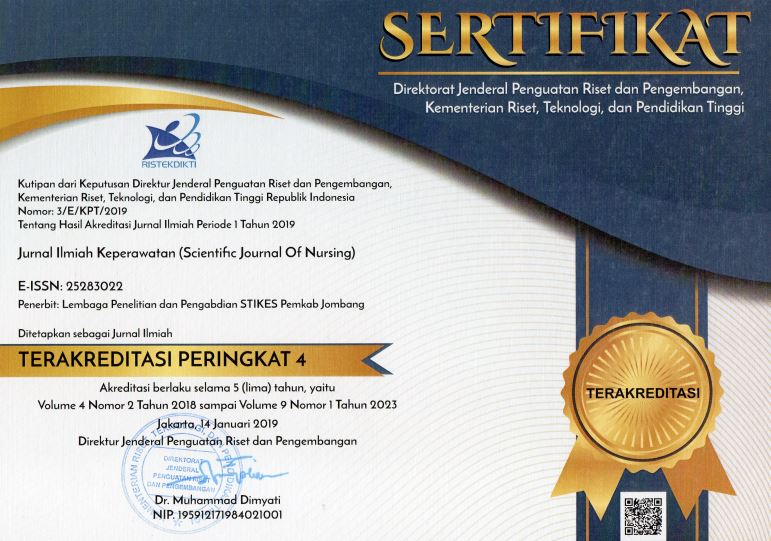KONDISI STRES DAN STRATEGI KOPING KELUARGA DALAM MENINGKATKAN KEPATUHAN PEMBATASAN CAIRAN KLIEN YANG MENJALANI PROGRAM HEMODIALISIS
Stress and family Coping Strategy in Improving Adherence of Fluid Restrictions on Client Undergoing Hemodialysis Program
DOI:
https://doi.org/10.33023/jikep.v6i1.357Keywords:
Stres, Strategi koping keluarga, haemodialisis, family centered nursingAbstract
Pendahuluan: Pembatasan cairan menjadi masalah utama klien PGK dengan hemodialisis. Kepatuhan terhadap pembatasan cairan dapat ditingkatkan melalui dukungan keluarga, ahli (perawat/ dokter), dan motivasi lingkungan. Dukungan sosial berpengaruh terhadap kepatuhan klien dalam pembatasan cairan. Tujuan penelitian ini menganalisis faktor-faktor yang berhubungan dengan meningkatkan kepatuhan pembatasan cairan klien hemodialisis. Metode: Jenis penelitian obsevasional study dengan desain cross-sectional. Sampel 110 klien hemodialisis dan keluarganya pada Juni 2019 di unit hemodialisa RSUD Kabupaten Jombang. Variabel independen adalah faktor keluarga: pengetahuan; pendapatan; lingkungan; struktur; fungsi dan tugas kesehatan; stress dan strategi koping keluarga. Variabel dependen adalah kepatuhan pembatasan cairan. Pengumpulan data dilakukan dengan kuesioner. Analisis data menggunakan Chi Square. Hasil: Stres dan strategi koping keluarga berhubungan terhadap kepatuhan pembatasan cairan klien PGK yang menjalani program hemodialisis dengan nilai p value (p=0.003 dan p= 0.000). Diskusi: efektivitas manajemen stres dan strategi koping keluarga akan mempengaruhi energi dan respons adaptif keluarga dalam menjalankan setiap peran dan fungsi dalam keluarga, semakin baik strategi koping keluarga, semakin baik kemampuan keluarga untuk menurunkan stres akan meningkatkan kesejahteraan dan mengontrol kesehatan mereka.
Downloads
References
Boyd, A., Yang, C. T., Estell, K., MS, C., Gerald, L. B., Dransfield, M., … Schwiebert, L. M. (2012). Feasibility of exercising adults with asthma: a randomized pilot study. Allergy, Asthma & Clinical Immunology, 8(1), 13. https://doi.org/10.1186/1710-1492-8-13
Clark, S., Farrington, K., & Chilcot, J. (2014). Nonadherence in dialysis patients: Prevalence, measurement, outcome, and psychological determinants. Seminars in Dialysis, 27(1), 42–49. https://doi.org/10.1111/sdi.12159
Düzalan, Ö. B., & Pakyüz, S. C. (2018). Educational interventions for improved diet and fluid management in haemodialysis patients : An interventional study. JPMA, 68, 532–537.
França-Pinto, A., Mendes, F. A. R., de Carvalho-Pinto, R. M., Agondi, R. C., Cukier, A., Stelmach, R., … Carvalho, C. R. F. (2015). Aerobic training decreases bronchial hyperresponsiveness and systemic inflammation in patients with moderate or severe asthma: a randomised controlled trial. Thorax, 70(8), 732–739. https://doi.org/10.1136/thoraxjnl-2014-206070
Friedman, M. M., Bowden, V. R., & Jones, E. G. (2010). Buku Ajar Keperawatan Keluarga: Riset, Teori dan Praktik. Jakarta: EGC.
Ghebre, M. A., Bafadhel, M., Desai, D., Cohen, S. E., Newbold, P., Rapley, L., … Brightling, C. E. (2015). Biological clustering supports both “dutch” and “british” hypotheses of asthma and chronic obstructive pulmonary disease. Journal of Allergy and Clinical Immunology, 135(1), 63–72.e10. https://doi.org/10.1016/j.jaci.2014.06.035
GINA. (2018). Global Strategy for Asthma Management and Prevention.
Grzela, K., Zagorska, W., Krejner, A., Litwiniuk, M., Zawadzka-Krajewska, A., Banaszkiewicz, A., … Grzela, T. (2015). Prolonged Treatment with Inhaled Corticosteroids does not Normalize High Activity of Matrix Metalloproteinase-9 in Exhaled Breath Condensates of Children with Asthma. Archivum Immunologiae et Therapiae Experimentalis, 63(3), 231–237. https://doi.org/10.1007/s00005-015-0328-z
Hall, C., Nici, L., Sood, S., Zuwallack, R., Castro, M., & Louis, S. (2017). Nonpharmacologic Therapy for Severe Persistent Asthma. The Journal of Allergy and Clinical Immunology: In Practice, 5(4), 928–935. https://doi.org/10.1016/j.jaip.2017.04.030
Howren, M. B., Kellerman, Q. D., Hillis, S. L., Cvengros, J., Lawton, W., & Christensen, A. J. (2016). Effect of a Behavioral Self-Regulation Intervention on Patient Adherence to Fluid-Intake Restrictions in Hemodialysis : a Randomized Controlled Trial. Ann. Behav. Med., 167–176. https://doi.org/10.1007/s12160-015-9741-0
Indonesian Renal Registry. (2015). 8th Report Of Indonesian Renal Registry. Program Indonesia Renal Registry, 1–45. https://doi.org/10.2215/CJN.02370316
Kim, Y., & Kim, M. (2015). The Experience of Fluid Management in Hemodialysis Patients. Korean Academy of Nursing Science, 45(5), 773–782.
Melegy, Z. & K. (2016). Effect of family centered empowerment model on hemodialysis patients and their caregivers, 6(11), 119–132. https://doi.org/10.5430/jnep.v6n11p119
Mohamed, Z., Riad, N. M., & Ahmed, F. H. (2013). Effect of Buteyko breathing technique on patients with bronchial asthma. Egyptian Journal of Chest Diseases and Tuberculosis, 61(4), 235–241. https://doi.org/10.1016/j.ejcdt.2012.08.006
Pakhale, S., Luks, V., Burkett, A., & Turner, L. (2013). Effect of physical training on airway inflammation in bronchial asthma: A systematic review. BMC Pulmonary Medicine, 13(1), 1. https://doi.org/10.1186/1471-2466-13-38
PDPI. (2012). Pedoman Praktis Diagnosis dan Penatalaksanaan di Indonesia. Jakarta: Departemen Kesehatan Republik Indonesia.
Pujiani, & Masruroh. (2017). Program Psikoedukasi Terhadap Peningkatan Kualitas Hidup Pasien Gagal Ginjal Kronik, 1(1), 47–56.
Sahat, C. S., Irawaty, D., & Hastono, S. P. (2011). Peningkatan kekuatan otot pernapasan dan fungsi paru melalui senam asma pada pasien asma. Jurnal Keperawatan Indonesia, 14, 101–106.
Stevenson, J., Tong, A., Gutman, T., Campbell, K. L., Craig, J. C., Brown, M. A., & Lee, V. W. (2018). Experiences and Perspectives of Dietary Management Among Patients on Hemodialysis: An Interview Study. Journal of Renal Nutrition, 1–11. https://doi.org/10.1053/j.jrn.2018.02.005
Victoria, A., Evangelos, F., & Sofia, Z. (2015). Family support , social and demographic correlations of non-adherence among haemodialysis patients, (August 2017). https://doi.org/10.11648/j.ajns.s.2015040201.21
Published
How to Cite
Issue
Section
Authors who publish with Jurnal Ilmiah Keperawatan (Scientific Journal of Nursing) agree to the following terms:
- Authors retain copyright and grant Jurnal Ilmiah Keperawatan (Scientific Journal of Nursing) the right of first publication with the work simultaneously licensed under a Creative Commons Attribution 4.0 International License that allows others to remix, adapt and build upon the work with an acknowledgment of the work's authorship and of the initial publication in Jurnal Ilmiah Keperawatan (Scientific Journal of Nursing).
- Authors are permitted to copy and redistribute the journal's published version of the work (e.g., post it to an institutional repository or publish it in a book), with an acknowledgment of its initial publication in Jurnal Ilmiah Keperawatan (Scientific Journal of Nursing).









